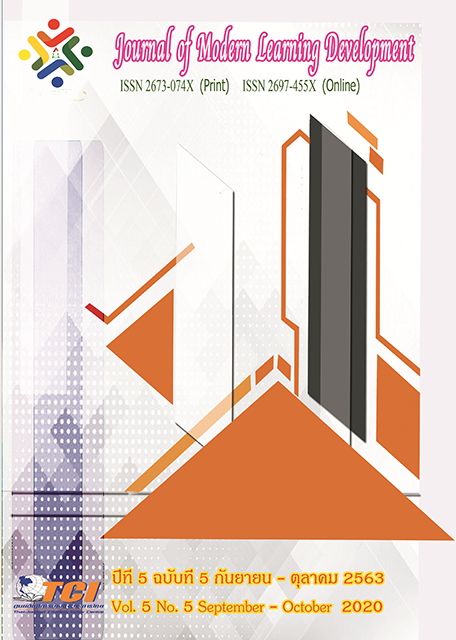An Analytical Study of Values and Importance of Majjhimā Paṭipadā in Dhammacakkappavattana Sutta
Main Article Content
Abstract
The objectives of this research were: 1) to study the principle of Majjhimā Paṭipadā (the Middle Path) in Theravada Buddhist scriptures; 2) to study the methods of practices according to the Majjhimā Paṭipadā in Dhammacakkappavattana Sutta ; 3) to analyze the advantages and values of the practice of Majjhimā Paṭipadā in Dhammacakkappavattana Sutta. This study was conducted by means of the documentary research by studying books, texts and Buddhist academic works. Its finding was presented by the descriptive analysis.
The research result revealed that Majjhimā Paṭipadā is the middle path of the Eightfold Noble Paths (Ariyamagga) appeared in the Mahāgopāla Sutta. It is called as the way to eliminate all suffering. It is named as ‘Ariyamagga’ because it is the practice of the noble one. It consists of eight elements. Its dhamma body of the right view is wisdom categorized as Pa11ācetasikadhamma. Other seven elements are the support of the right view.
Majjhimā Paṭipadā is the Eightfold Noble Paths leading to the end of suffering, attainment of Nirvana. The practitioners see the Four Noble Truth by Magga1āṇa and realize Nirvana by Phala1āṇa. As Nirvana is the ultimate goal of Buddhism and practitioners to end suffering and eliminate the cycle of existence; therefore, the Buddha said ‘one of achievement is the elimination of suffering, Rūpa-nāma (nibbānāya samvattati); when the Arahant passed away, they ended the cycle of birth; this is the end of suffering’.
Article Details
References
ฉัตรทิพย์ นาถสุภา. (2515). เศรษฐกิจไทย : โครงสร้าง ปัญหา และนโยบาย บรรณาธิการหนังสือว่าด้วย สมาคมเศรษฐศาสตร์. กรุงเทพมหานคร: จุฬาลงกรณ์มหาวิทยาลัย.
พจนานุกรมราชบัณฑิตยสถาน. (2543). พจนานุกรมศัพท์ปรัชญา อังกฤษ-ไทย. กรุงเทพมหานคร: บริษัท เท็กช์แอนเจอร์นัล พับลิเคชั่น จำกัด.
พระธรรมปิฎก (ป.อ. ปยุตฺโต). (2546). พุทธธรรม ฉบับปรับปรุงและขยายความ. (พิมพ์ครั้งที่ 10). กรุงเทพมหานคร: บริษัท สหธรรมมิก จำกัด.
พระโพธิญาณเถระ (หลวงพ่อชา สุภทฺโท). (2526). นอกเหตุเหนือผล. กรุงเทพมหานคร: โรงพิมพ์เม็ดทราย.
พระมงคลเทพมุนี (สด จนฺทสโร). (2551) คำสอนหลวงปู่สู่โลกปัจจุบัน. กรุงเทพมหานคร: โรงพิมพ์ เอส.เอ็ม.เค พริ้นติ้ง จำกัด.
พระมหาสมจินต์ สมฺมาปญฺโญ. (2542). วิพากษ์ทางสายกลางของอริสโตเติลกับมัชฌิมาในพระพุทธศาสนาเถรวาท. สารนิพนธ์พุทธศาสตรบัณฑิตรุ่นที่ 43. กรุงเทพมหานคร: โรงพิมพ์มหาจุฬาลงกรณราชวิทยาลัย.
พุทธทาสภิกขุ. (2546). อริยสัจจากพระโอษฐ์ ภาคปลาย. (พิมพ์ครั้งที่ 12) . สุราษฎร์ธานี: มูลนิธิธรรมทานไชยา.
มหาจุฬาลงกรณราชวิทยาลัย. (2539). พระไตรปิฎกภาษาไทย ฉบับมหาจุฬาลงกรณราชวิทยาลัย. กรุงเทพมหานคร: โรงพิมพ์มหาจุฬาลงกรณราชวิทยาลัย.
เสฐียรพงษ์ วรรณปก ราชบัณฑิต. (2547). มัชฌิมาปฏิปทา : ทางสายกลางสองมิติ สัปปุริสธรรม 7 นัยที่สอง. กรุงเทพมหานคร: โรงพิมพ์พีอาร์ คัลเลอร์พริ้นท์.
สุดใจ สุวรรณชีวะศิริ. (2554). ศึกษาหลักมัชฌิมาปฏิปทาในมหาโคปาลสูตร. วิทยานิพนธ์พุทธศาสตรมหาบัณฑิต. บัณฑิตวิทยาลัย: มหาจุฬาลงกรณราชวิทยาลัย.


